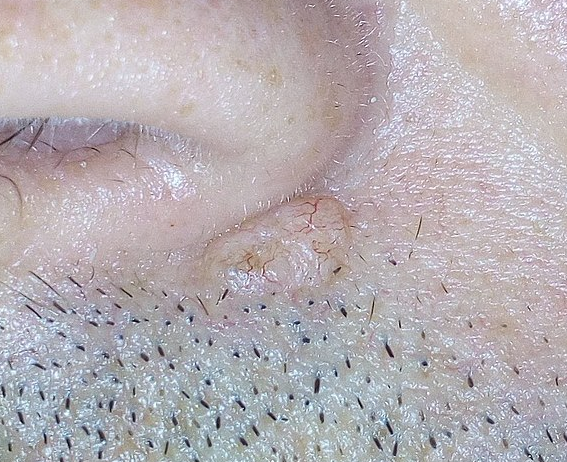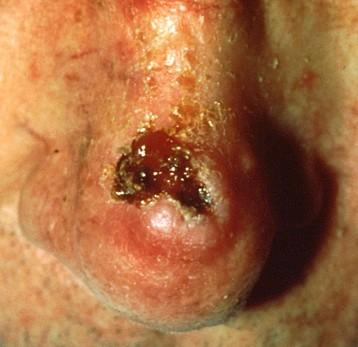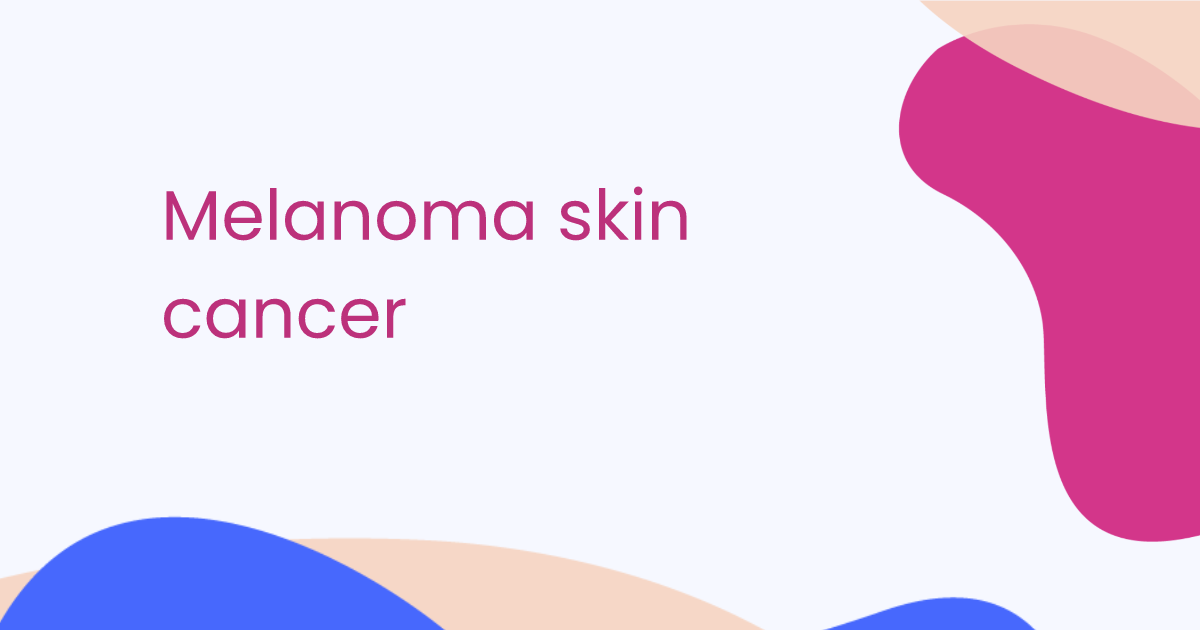Non-melanoma skin cancer
Peer reviewed by Dr Toni Hazell, MRCGPLast updated by Dr Philippa Vincent, MRCGPLast updated 24 May 2023
Meets Patient’s editorial guidelines
- DownloadDownload
- Share
- Language
- Discussion
Non-melanoma skin cancers are any skin cancers that are not melanoma. The term is used because melanoma is very different to other skin cancers so it's important to think of them as separate types of skin cancers.
Basal cell carcinomas (BCCs) and squamous cell carcinomas (SCCs) are the main types of non-melanoma skin cancers.
In this article:
Continue reading below
Types of non-melanoma skin cancer
Basal cell carcinoma. This is a skin cancer, usually caused by sun exposure, but which rarely spreads or causes further symptoms.
Squamous cell carcinoma. This is a skin cancer, commoner with age, caused by sun exposure and other environmental factors such as smoking. It can spread.
Who gets non-melanoma skin cancer?
BCCs and SCCs both become more common with increasing age. Most basal cell carcinomas (BCCs) and squamous cell carcinomas (SCCs) occur in older people. Over 7 in 10 cases occur in people over the age of 60. BCCs are more common in people who have had lots of sun exposure during their lives.
Continue reading below
How common is non-melanoma skin cancer?
Over 60,000 people in the UK develop a BCC or SCC each year. (BCC is the most common type of all cancers) They are very rare in children. BCC is the most common skin cancer in white and fair-skinned people.
Non-melanoma skin cancer symptoms
Medical advice should be sought where a new skin lesion develops which does not go away within a few weeks.
Basal cell carcinoma (BCC) symptoms
A BCC typically develops on a sun-exposed area of the skin such as the scalp or face. However, one can develop on any area of skin. The first sign is often a small red, pink or pearly lump which appears on previously normal skin. The lump is often dome-shaped. They usually grow very slowly and it can take many months for one to grow to a centimetre or more. They are not usually painful.
Over time, the lump on the skin may crust over, ulcerate or bleed from time to time. A skin ulcer caused by a BCC (which is sometimes called a rodent ulcer) often looks like a small crater with a raised edge. BCCs very rarely spread (metastasise) to other parts of the body. However, if left untreated they continue to grow locally and can cause damage to nearby structures. For example, a BCC on the face may erode and damage the nose or an ear.
This photo shows a small BCC just below and to the left of a man's nose.
Basal cell carcinoma under the nose

By Skarmoutsos V (Own work) via Wikimedia Commons
Squamous cell carcinoma (SCC) symptoms
An SCC typically develops on the face - most commonly on or around the ears or lips. But, again, any area of skin can be affected. It typically starts as a small crusted or scaly area of skin with a red or pink base. It may grow into a lump. An SCC may ulcerate or bleed from time to time. Unlike BCCs, SCCs are often painful.
As an SCC grows larger and deeper, it damages nearby structures. For example, if left untreated, an SCC next to a nose or ear can grow into, erode and then completely destroy the nose or ear. An SCC may also spread to other areas of the body. However, this is uncommon in the early stages and most are treated before any spread occurs.
Bowen's disease is a condition which is thought to be an early pre-cancerous SCC. It looks like a flat red-brown, scaly patch which may resemble psoriasis or eczema. If untreated, it may become a true SCC.
This image shows a SCC on the tip of someone's nose. Note how it has ulcerated and looks more angry than a BCC.
Squamous cell carcinoma on the tip of the nose

By US government, with derivative work by James Heilman, via Wikimedia Commons
Continue reading below
What causes non-melanoma skin cancer?
A cancerous tumour starts from one abnormal cell. The exact reason why a cell becomes cancerous is unclear. It is thought that something damages or alters certain genes in the cell. This makes the cell abnormal and multiply out of control.
Sun damage to skin
A BCC typically develops on a sun-exposed area of the skin such as the scalp and face. The main risk factor for a BCC is sun exposure.
People most at risk of sun damage are people with fair skin., especially those with skin which would never tan, those with red or blond hair or green or blue eyes. The sun damage occurs even when there has not been actual sunburn. Dark-skinned people rarely develop BCC, as the melanin in their skin (the darker the skin the more melanin) protects against sun damage.
Someone who works outside a lot, like a gardener, is at greater risk of getting a BCC in later life; someone with pale skin who has lived in a very sunny part of the world is also more at risk.
SCCs can also be brought on by too much sun exposure but they are also caused by other things like smoking, excessive alcohol or being on immunosuppressant medication.
Someone who has received an organ transplant and is on medications that suppress the immune system is at an increased risk of developing an SCC later in life. A bad knock or skin injury in an elderly person can cause an SCC to develop in the injured skin.
Other risk factors
Other factors which increase the risk of developing an SCC or BCC include the following:
A family history of skin cancer. This may be related to inheriting fair skin which is more easily sun-damaged but other genetic factors may play a part in some cases.
Using sunbeds or similar tanning machines which emit UV light.
Having a solar keratosis (actinic keratosis). This is a small, rough bump which develops on the skin. It is caused by a lot of exposure to the sun over many years.
Having already had a previous skin cancer.
Occasionally, a skin cancer can develop on an area of skin previously damaged with a burn, scar, a long-standing sore, persistent inflammation, X-ray exposure or certain chemicals (such as arsenic or creosote).
A weakened immune system.
Some rare inherited disorders, which are associated with an increased risk, such as albinism, xeroderma pigmentosa, Gorlin's syndrome and Bazex syndrome.
Diagnosis of non-melanoma skin cancer
Doctors are adept at diagnosing BCCs and SCCs. The initial suspicion is based on the way a BCC or an SCC looks. BCCs are relatively easy to diagnose; SCCs can be confused with other skin conditions but it is usually easy to tell when these need to be seen urgently by a dermatologist (skin specialist). Many doctors will use a dermatoscope, a handheld microscope, to help with the diagnosis. In some areas of the UK, photographs of the skin lesion, taken using the dermatoscope, will be sent to a dermatologist to decide whether a referral is needed.
Editor’s note
Dr Krishna Vakharia, 16th October 2023
The National Institute for Health and Care Excellence (NICE) has recommended that a person should receive a diagnosis or ruling out of cancer within 28 days of being referred urgently by their GP for suspected cancer.
Biopsy
A small sample (biopsy) of tissue can be taken from a suspicious lump on the skin by a dermatologist. This is looked at under the microscope, which can confirm the diagnosis. If the skin lump is small, the whole lump may be removed and then looked at under the microscope (an excisional biopsy). This may diagnose and cure the problem at the same time.
Further tests
No further tests are usually needed for a BCC or an SCC which is diagnosed when it is small. If a doctor suspects that there has been some spread from an SCC to other parts of the body then further tests such as X-rays, blood tests or scans may be advised.
Non-melanoma skin cancer treatment
Treatment for small skin cancers
Most cases are diagnosed when the skin cancer is still quite small. Depending on the site, size and depth of the tumour, one of the following treatments may be used:
A common treatment is a simple operation done under local anaesthetic to cut out the cancer. The edges of the normal skin are then stitched together.
Cryosurgery. This is a freezing treatment with liquid nitrogen which destroys cancer cells.
Photodynamic therapy. This is a special kind of light therapy which kills cancer cells.
Chemotherapy creams are sometimes placed on skin cancers to kill cancer cells. These are usually either 5-fluorouracil (5-FU) or imiquimod.
Mohs' micrographic surgery is done in some situations. In this technique, the tumour is removed piece by piece. Each piece is looked at under the microscope straightaway for cancer cells. Further pieces are removed until no cancer cells are seen. The aim is to remove all the cancer but to remove as little healthy tissue as possible. This is often used where the non-melanoma skin cancer is on the face in an area which is close to important structures eg, eyes or where there can be a significant cosmetic impact.
More extensive surgery is needed in some cases
If the skin cancer is larger, a more extensive operation may be required. This may need a general anaesthetic. For example, if a large area of affected skin is cut away you may need plastic surgery to place a skin graft over the wound.
If an SCC has spread to the nearby lymph glands (nodes) then an operation to remove these glands may be advised.
Other treatments
Radiotherapy is sometimes used as an alternative to surgery. For example, if the area covered by the cancer is large, if the site is difficult to operate on or if an operation cannot be done for any other reason. Radiotherapy is a treatment which uses high-energy beams of radiation which are focused on cancerous tissue to kill cancer cells.
If an SCC has spread to lymph nodes or other areas of the body, radiotherapy and/or chemotherapy may be used to treat the secondary cancers.
What is the outlook for non-melanoma skin cancer?
The outlook (prognosis) for almost all BCCs is that they can be treated and cured, mostly with a simple operation or other simple technique. They don't spread to other parts of the body. Most SCCs can also be treated and cured as most are treated before there has been any spread to other parts of the body. Treatment is less likely to be curative if there has been any spread to other parts of the body.
Note: people who have one skin cancer have an increased risk of developing another one in the future.
Can non-melanoma skin cancer be prevented?
For BCCs, standard sun-protection advice can help prevent them. Avoiding the sun at its peak in midday, using sun cream, wearing hats, avoiding getting sunburnt and never using tanning booths can all help. People with fair skin should use sun cream even when the sun does not seem particularly fierce. Bald(ing) men should ensure they were hats when they are outside on sunny days.
For SCCs, general sun protection advice is also a good idea but trying to prevent SCCs probably depends more on a generally healthy lifestyle, ie no smoking and only drinking alcohol in moderation. Anyone taking immunosuppressant medication should report any skin growths to their doctor.
See the separate leaflet called Preventing Skin Cancer for more details.
Patient picks for Skin cancer types

Cancer
Preventing skin cancer
Some skin cancers can be partly prevented by protecting yourself from the sun, not smoking, and generally taking care of your health. Some kinds of skin cancer can't be prevented however, because they are caused by something going wrong in your genes: this is beyond your control.
by Dr Oliver Starr, MRCGP

Cancer
Melanoma skin cancer
Melanoma (also called malignant melanoma) is the most serious type of skin cancer. It affects young adults as well as older people. It can be caused by too much sun exposure, but sometimes even people who haven't had much sun get melanoma too. The treatment for melanoma is mainly surgical but other treatments, including chemotherapy and radiotherapy, are increasingly used, especially if it is not possible to remove all the melanoma or if the melanoma is diagnosed at a relatively late stage.
by Dr Doug McKechnie, MRCGP
Further reading and references
- Suspected cancer: recognition and referral; NICE guideline (2015 - last updated May 2025)
- Basal cell carcinoma; British Association of Dermatologists, 2022
- Squamous Cell Carcinoma; British Association of Dermatologists, 2022
- Basal Cell Carcinoma; DermNet NZ
- Squamous Cell Carcinoma; DermNet NZ
Continue reading below
Article history
The information on this page is written and peer reviewed by qualified clinicians.
Next review due: 12 May 2028
24 May 2023 | Latest version

Ask, share, connect.
Browse discussions, ask questions, and share experiences across hundreds of health topics.

Feeling unwell?
Assess your symptoms online for free
Sign up to the Patient newsletter
Your weekly dose of clear, trustworthy health advice - written to help you feel informed, confident and in control.
By subscribing you accept our Privacy Policy. You can unsubscribe at any time. We never sell your data.